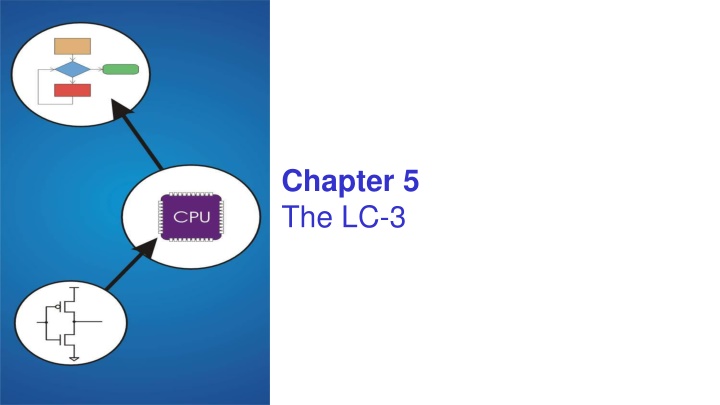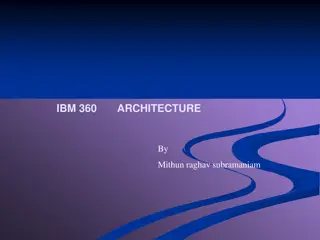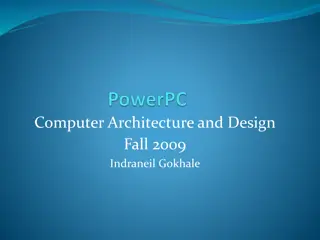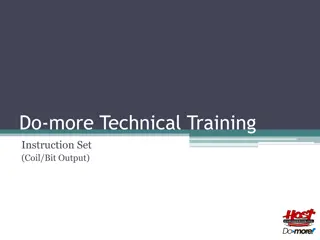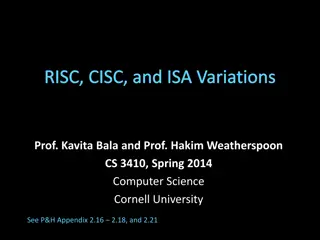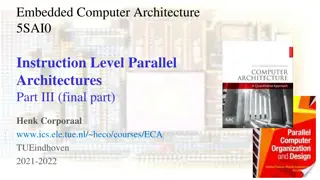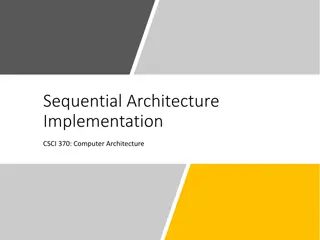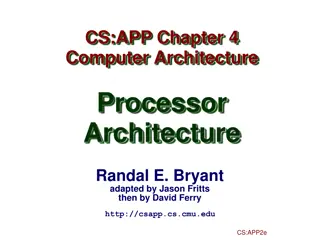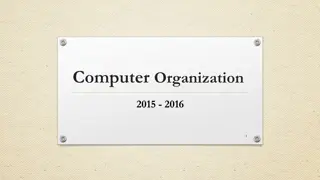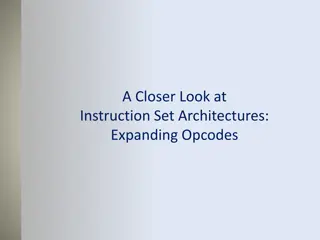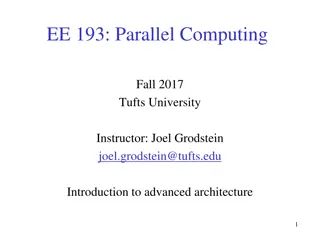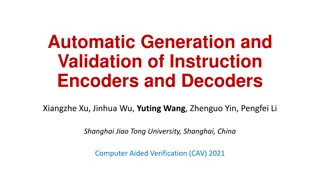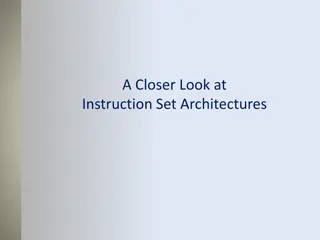LC-3 Instruction Set Architecture Overview
LC-3 is a computer architecture that provides information on memory organization, register sets, instruction processing, and opcodes. It includes details on memory address space, registers, instruction types, addressing modes, and operate instructions such as ADD, AND, and NOT. The architecture supports data movement, control instructions, and data types for writing programs in machine language. LC-3's instruction set consists of 15 opcodes, each serving specific functions, and the addressing modes used include immediate, PC-relative, indirect, and base+offset.
Download Presentation

Please find below an Image/Link to download the presentation.
The content on the website is provided AS IS for your information and personal use only. It may not be sold, licensed, or shared on other websites without obtaining consent from the author.If you encounter any issues during the download, it is possible that the publisher has removed the file from their server.
You are allowed to download the files provided on this website for personal or commercial use, subject to the condition that they are used lawfully. All files are the property of their respective owners.
The content on the website is provided AS IS for your information and personal use only. It may not be sold, licensed, or shared on other websites without obtaining consent from the author.
E N D
Presentation Transcript
Chapter 5 The LC-3
Instruction Set Architecture ISA = All of the programmer-visible components and operations of the computer memory organization address space -- how may locations can be addressed? addressibility -- how many bits per location? register set how many? what size? how are they used? instruction set opcodes data types addressing modes ISA provides all information needed for someone that wants to write a program in machine language (or translate from a high-level language to machine language).
LC-3 Overview: Memory and Registers Memory address space: 216locations (16-bit addresses) addressability: 16 bits Registers temporary storage, accessed in a single machine cycle accessing memory generally takes longer than a single cycle eight general-purpose registers: R0 - R7 each 16 bits wide how many bits to uniquely identify a register? other registers not directly addressable, but used by (and affected by) instructions PC (program counter) CC (condition codes) IR (instruction register) MAR (memory address register) MDR (memory data register)
Instruction Processing: FETCH Load next instruction (at address stored in PC) from memory into Instruction Register (IR). Copy contents of PC into MAR. Send read signal to memory. Copy contents of MDR into IR. F D EA Then increment PC, so that it points to the next instruction in sequence. PC becomes PC+1. OP EX S
LC-3 Overview: Instruction Set Opcodes 15 opcodes Operate instructions: ADD, AND, NOT Data movement instructions: LD, LDI, LDR, LEA, ST, STR, STI Control instructions: BR, JSR/JSRR, JMP, RTI, TRAP some opcodes set/clear condition codes, based on result: N = negative, Z = zero, P = positive (> 0) Data Types 16-bit 2 s complement integer Addressing Modes How is the location of an operand specified? non-memory addresses: immediate, register memory addresses: PC-relative, indirect, base+offset
Operate Instructions Only three operations: ADD, AND, NOT Other operations can be built from these primitives Source and destination operands are registers These instructions do not reference memory. ADD and AND can use immediate mode, where one operand is hard-wired into the instruction.
Dataflow diagrams Diagrams illustrate when and where data moves to accomplish the desired operation Components in data flow diagrams: Registers: each register can hold 16 bits in LC-3. Several Register File: contains eight 16-bit registers ALU: combinational (no storage). Two inputs, one output, functionality can be selected. SEXT: combinational. Sign extension from 5 to 16 bits. Memory: 216 words. Addressed by 16 bit MAR and MDR holds data How components are implemented? Last third of the class
NOT (Register) Assembly Ex: NOT R3, R2 Note: Src and Dst could be the same register.
this zero means register mode ADD/AND (Register) Assembly Ex: Add R3, R1, R3
this one means immediate mode ADD/AND (Immediate) Assembly Ex: Add R3, R3, #1 Note: Immediate field is sign-extended.
Using Operate Instructions With only ADD, AND, NOT How do we subtract? How do we OR? Hint: Demorgan s law How do we copy from one register to another? How do we initialize a register to zero?
Data Movement Instructions Load -- read data from memory to register LD: PC-relative mode LDR: base+offset mode LDI: indirect mode Store -- write data from register to memory ST: PC-relative mode STR: base+offset mode STI: indirect mode Load effective address -- compute address, save in register LEA: immediate mode does not access memory
PC-Relative Addressing Mode Want to specify address directly in the instruction But an address is 16 bits, and so is an instruction! After subtracting 4 bits for opcode and 3 bits for register, we have 9 bits available for address. Solution: Use the 9 bits as a signed offset from the current PC. 255 + 256 offset 9 bits: Can form any address X, such that: 255 + PC 256 X PC Remember that PC is incremented as part of the FETCH phase; This is done before the EVALUATE ADDRESS stage.
Assembly Ex: LD R1, Label1 LD (PC-Relative)
Assembly Ex: ST R1, Label2 ST (PC-Relative)
Indirect Addressing Mode With PC-relative mode, can only address data within 256 words of the instruction. What about the rest of memory? Solution #1: Read address from memory location, then load/store to that address. First address is generated from PC and IR (just like PC-relative addressing), then content of that address is used as target for load/store.
Assembly Ex: LDI R4, Adr LDI (Indirect)
Assembly Ex: STI R4, Adr STI (Indirect)
Base + Offset Addressing Mode With PC-relative mode, can only address data within 256 words of the instruction. What about the rest of memory? Solution #2: Use a register to generate a full 16-bit address. 4 bits for opcode, 3 for src/dest register, 3 bits for base register -- remaining 6 bits are used as a signed offset. Offset is sign-extended before adding to base register.
Assembly Ex: LDR R4, R1, #1 LDR (Base+Offset)
Assembly Ex: STR R4, R1, #1 STR (Base+Offset)
Load Effective Address Computes address like PC-relative (PC plus signed offset) and stores the result into a register. The address is stored in the register, not the contents of the memory location. Works like the & (address of operator) in C Note: LEA LDR R1, Begin R3, R1, #0 We can use the destination register as a pointer
LEA (Immediate) Assembly Ex: LEA R1, Lab1
LC3 Addressing Modes: Comparison Instruction Example Destination Source NOT NOT R2, R1 R2 R1 ADD / AND (imm) ADD R3, R2, #7 R3 R2, #7 R2, R1 ADD / AND (reg) ADD R3, R2, R1 R3 M[LABEL] LD LD R4, LABEL R4 ST ST R4, LABEL M[LABEL] R4 M[M[LABEL]] LDI LDI R4, LABEL R4 STI STI R4, LABEL M[M[LABEL]] R4 LDR R4 LDR R4, R2, # 5 M[R2 5] STR STR R4, R2, #5 M[R2 + 5] R4 LEA LEA R4, LABEL R4 address of LABEL
Control Instructions Used to alter the sequence of instructions (by changing the Program Counter) Conditional Branch branch is taken if a specified condition is true signed offset is added to PC to yield new PC else, the branch is not taken PC is not changed, points to the next sequential instruction Unconditional Branch (or Jump) always changes the PC TRAP changes PC to the address of an OS service routine routine will return control to the next instruction (after TRAP)
Condition Codes LC-3 has three condition code registers: N -- negative Z -- zero P -- positive (greater than zero) Set by any instruction that writes a value to a register (ADD, AND, NOT, LD, LDR, LDI, LEA) Exactly one will be set at all times Based on the last instruction that altered a register
Branch Instruction Branch specifies one or more condition codes. If the set bit is specified, the branch is taken. PC-relative addressing: target address is made by adding signed offset (IR[8:0]) to current PC. Note: PC has already been incremented by FETCH stage. Note: Target must be within 256 words of BR instruction. If the branch is not taken, the next sequential instruction is executed.
BR (PC-Relative) What happens if bits [11:9] are all zero? All one?
Using Branch Instructions Compute sum of array of four integers. array starts at location x300C, program starts at location x3000. Algorithm: (the hard part, converting to assembly is relatively simple) pointer variable set to the of beginning of array sum variable set to 0 counter variable set to 4 while counter not equal to 0 load first value into a temp variable add temp variable to sum increment pointer decrement counter R1 x300C R3 0 R2 4 R4 M[R1] R3 R3+R4 R1 R1+1 R2 R2-1 R2=0? NO YES
R1 x300C R3 0 R2 4 Sum of 4 integers R4 M[R1] R3 R3+R4 R1 R1+1 R2 R2-1 ;Computes sum of integers ;R1: pointer, initialized to NUMS (x300C) ;R3: sum, initially cleared, accumulated here ;R2: down counter, initially holds 4 .ORIG 0x3000 R2=0? NO YES LEA R1,NUMS AND R3,R3, #0 AND R2,R2, #0 ADD R2, R2, #4 DONE NUMS SUM ST R3, SUM ;added HALT .FILL 3 .FILL -4 .FILL 7 .FILL 3 .BLKW 1 .END LOOP BRz DONE LDR R4,R1,#0 ADD R3,R3,R4 ADD R1,R1,#1 ADD R2,R2,#-1 BRnzp LOOP
JMP (Register) Jump is an unconditional branch -- always taken. Target address is the contents of a register. Allows any target address.
TRAP Calls a service routine, identified by 8-bit trap vector. vector routine input a character from the keyboard x23 output a character to the monitor x21 halt the program x25 When routine is done, PC is set to the instruction following TRAP. (We ll talk about how this works later.)
Another Example Count the occurrences of a character in an array Program begins at location x3000 Read character from keyboard Load each character from array Starting address of array is stored in the memory location immediately after the program If character equals input character, increment counter The end of the array is indicated by a special ASCII value: EOT (x04) At the end, print the number of characters and halt (assume there will be less than 10 occurrences of the character) A special character used to indicate the end of a sequence is often called a sentinel. Useful when you don t know ahead of time how many times to execute a loop.
Flow Chart Count = 0 (R2 = 0) Convert count to ASCII character (R0 = x30, R0 = R2 + R0) YES Done? (R1 ?= EOT) Ptr = 1st file character (R3 = M[x3012]) NO Print count (TRAP x21) Match? (R1 ?= R0) YES NO Input char from keybd (TRAP x23) HALT (TRAP x25) Incr Count (R2 = R2 + 1) Load char from file (R1 = M[R3]) Load next char from file (R3 = R3 + 1, R1 = M[R3])
LC3 Assembly .ORIG x3000 AND R2, R2, #0 LD R3, PTR TRAP x23 LDR R1 ,R3, #0 ; ; Test character for end of file ; TEST ADD R4, R1, #-4 BRz OUT ; ; Test character for match. If a match, increment count. ; NOT R1, R1 ADD R1, R1, R0 NOT R1, R1 BRnp GETC ADD R2, R2, #1 ; Get next character from the file ; GETC ADD R3, R3, #1 ; Increment the pointer LDR R1, R3, #0 ; R1 gets the next character to test BRnzp TEST ; ; Output the count. ; OUT LD R0, ASCII ; Load the ASCII template ADD R0, R0, R2 ; Convert binary to ASCII TRAP x21 ; ASCII code in R0 is displayed TRAP x25 ; Halt machine ; ; Storage for pointer and ASCII template ; ASCII .FILL x0030 PTR .FILL x3014 .END ; R2 is counter, initialize to 0 ; R3 is pointer to characters ; R0 gets character input ; R1 gets the next character D A B ; Test for EOT ; If done, prepare the output E C ; If match, R1 = xFFFF ; If match, R1 = x0000 ; no match, do not increment 2) What instruction would need to be changed if the null terminator (0) is used to signal the end of the 1) What instruction dereferences a pointer to load a character into a register?
LC3 Assembly .ORIG x3000 AND R2, R2, #0 LD R3, PTR TRAP x23 LDR R1 ,R3, #0 ; ; Test character for end of file ; TEST ADD R4, R1, #-4 BRz OUT ; ; Test character for match. If a match, increment count. ; NOT R1, R1 ADD R1, R1, R0 NOT R1, R1 BRnp GETC ADD R2, R2, #1 ; Get next character from the file ; GETC ADD R3, R3, #1 ; Increment the pointer LDR R1, R3, #0 ; R1 gets the next character to test BRnzp TEST ; ; Output the count. ; OUT LD R0, ASCII ; Load the ASCII template ADD R0, R0, R2 ; Convert binary to ASCII TRAP x21 ; ASCII code in R0 is displayed TRAP x25 ; Halt machine ; ; Storage for pointer and ASCII template ; ASCII .FILL x0030 PTR .FILL x3014 .END ; R2 is counter, initialize to 0 ; R3 is pointer to characters ; R0 gets character input ; R1 gets the next character D A B ; Test for EOT ; If done, prepare the output E C ; If match, R1 = xFFFF ; If match, R1 = x0000 ; no match, do not increment 4) What instruction loads the PC with the value found at an address in the first x100 locations of memory 3) What check/test could be accomplished with a NOT then an ADD of 1 then an ADD
